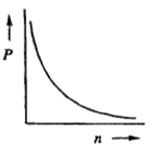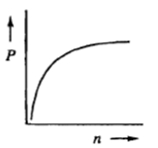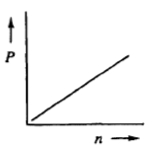By rearranging the ideal gas law, we can establish direct and inverse relationships between its variables. So here we have the ideal gas law formula, which is pv = nrt. R is our gas constant. Because it's constant, we don't have to relate it to the other variables. Next, we have our variable chart and we'll see what effect happens to the other variables if pressure is increasing and volume is increasing. And then in our variable relationships we'll take a look at different pairs of variables and see whether they are directly proportional or inversely proportional to one another. Alright. So first, let's look at what happens when I increase pressure. Let's see what is the effect that it has on volume. Our equation is pv = nrt. We're not gonna talk about n r t because we're looking strictly at the relationship between pressure and volume. Now to make them relate to one another, we're gonna say that this is equal to a constant, let's just say that it's 1, and we're gonna bring volume over to the other side. By doing that, we can see that the relationship is that pressure is equal to 1 / v. Pressure here is a numerator, volume is a denominator. If you've watched my other videos in terms of direct and inverse relationships, realize that because they're on different levels, they're inversely proportional. If volume is increasing and the top is staying constant, if volume is increasing that means pressure would be decreasing. If volume is decreasing, pressure would be increasing. So coming back to our variables chart we're gonna say that the relationship is if we increase my pressure that's gonna decrease my volume because they have an inversely proportional relationship or opposite relationship. Now let's compare pressure and moles. Okay. So pressure and moles, ignore volume r and t. So then this would just be pressure equals moles. They're both numerators, both on the same level. If I increase 1 that's gonna cause an increase in the other. So increasing pressure while keeping all the other variables out increases my moles. Since they're increasing or decreasing together, they are directly proportional. Next, pressure equals temperature. Right? Ignore volume, moles, and r because we're focusing only on pressure and temperature. Again, they're both numerators so they both increase together. So they are directly proportional. Alright. Now that we've done that let's look at volume. So volume, we're increasing volume and we're trying to see what effect it has on my moles and my temperature here. So focus on only moles and volume. Ignore pressure, ignore r and t. Volume and moles are on the same level with one another. They're both numerators, so increasing one would cause an increase in the other. Why? Because they are directly proportional. And then finally, volume equals temperature. So at this point, you've seen us do the other ones. Give yourself a second pause in the video if you want and see what the relationship between volume and temperature would be. Alright. Hopefully you've done that and realize that volume and temperature, both of them considered numerators, both on the same level, an increase in one will cause an increase in the other. Why? Because they too would be directly proportional. So these are the relationships that we can establish with the variables of the ideal gas law. And we can see that really only pressure and volume is where we would see an inverse relationship when doing these pairings of the variables. So keep this in mind if you're faced with any type of theoretical question where they're increasing or decreasing one variable and asking for the effect on another within the ideal gas law.
- 1. Matter and Measurements4h 29m
- What is Chemistry?5m
- The Scientific Method9m
- Classification of Matter16m
- States of Matter8m
- Physical & Chemical Changes19m
- Chemical Properties8m
- Physical Properties5m
- Intensive vs. Extensive Properties13m
- Temperature (Simplified)9m
- Scientific Notation13m
- SI Units (Simplified)5m
- Metric Prefixes24m
- Significant Figures (Simplified)11m
- Significant Figures: Precision in Measurements7m
- Significant Figures: In Calculations19m
- Conversion Factors (Simplified)15m
- Dimensional Analysis22m
- Density12m
- Specific Gravity9m
- Density of Geometric Objects19m
- Density of Non-Geometric Objects9m
- 2. Atoms and the Periodic Table5h 23m
- The Atom (Simplified)9m
- Subatomic Particles (Simplified)12m
- Isotopes17m
- Ions (Simplified)22m
- Atomic Mass (Simplified)17m
- Atomic Mass (Conceptual)12m
- Periodic Table: Element Symbols6m
- Periodic Table: Classifications11m
- Periodic Table: Group Names8m
- Periodic Table: Representative Elements & Transition Metals7m
- Periodic Table: Elemental Forms (Simplified)6m
- Periodic Table: Phases (Simplified)8m
- Law of Definite Proportions9m
- Atomic Theory9m
- Rutherford Gold Foil Experiment9m
- Wavelength and Frequency (Simplified)5m
- Electromagnetic Spectrum (Simplified)11m
- Bohr Model (Simplified)9m
- Emission Spectrum (Simplified)3m
- Electronic Structure4m
- Electronic Structure: Shells5m
- Electronic Structure: Subshells4m
- Electronic Structure: Orbitals11m
- Electronic Structure: Electron Spin3m
- Electronic Structure: Number of Electrons4m
- The Electron Configuration (Simplified)22m
- Electron Arrangements5m
- The Electron Configuration: Condensed4m
- The Electron Configuration: Exceptions (Simplified)12m
- Ions and the Octet Rule9m
- Ions and the Octet Rule (Simplified)8m
- Valence Electrons of Elements (Simplified)5m
- Lewis Dot Symbols (Simplified)7m
- Periodic Trend: Metallic Character4m
- Periodic Trend: Atomic Radius (Simplified)7m
- 3. Ionic Compounds2h 18m
- Periodic Table: Main Group Element Charges12m
- Periodic Table: Transition Metal Charges6m
- Periodic Trend: Ionic Radius (Simplified)5m
- Periodic Trend: Ranking Ionic Radii8m
- Periodic Trend: Ionization Energy (Simplified)9m
- Periodic Trend: Electron Affinity (Simplified)8m
- Ionic Bonding6m
- Naming Monoatomic Cations6m
- Naming Monoatomic Anions5m
- Polyatomic Ions25m
- Naming Ionic Compounds11m
- Writing Formula Units of Ionic Compounds7m
- Naming Ionic Hydrates6m
- Naming Acids18m
- 4. Molecular Compounds2h 18m
- Covalent Bonds6m
- Naming Binary Molecular Compounds6m
- Molecular Models4m
- Bonding Preferences6m
- Lewis Dot Structures: Neutral Compounds (Simplified)8m
- Multiple Bonds4m
- Multiple Bonds (Simplified)6m
- Lewis Dot Structures: Multiple Bonds10m
- Lewis Dot Structures: Ions (Simplified)8m
- Lewis Dot Structures: Exceptions (Simplified)12m
- Resonance Structures (Simplified)5m
- Valence Shell Electron Pair Repulsion Theory (Simplified)4m
- Electron Geometry (Simplified)8m
- Molecular Geometry (Simplified)11m
- Bond Angles (Simplified)11m
- Dipole Moment (Simplified)15m
- Molecular Polarity (Simplified)7m
- 5. Classification & Balancing of Chemical Reactions3h 17m
- Chemical Reaction: Chemical Change5m
- Law of Conservation of Mass5m
- Balancing Chemical Equations (Simplified)13m
- Solubility Rules16m
- Molecular Equations18m
- Types of Chemical Reactions12m
- Complete Ionic Equations18m
- Calculate Oxidation Numbers15m
- Redox Reactions17m
- Spontaneous Redox Reactions8m
- Balancing Redox Reactions: Acidic Solutions17m
- Balancing Redox Reactions: Basic Solutions17m
- Balancing Redox Reactions (Simplified)13m
- Galvanic Cell (Simplified)16m
- 6. Chemical Reactions & Quantities2h 35m
- 7. Energy, Rate and Equilibrium3h 46m
- Nature of Energy6m
- First Law of Thermodynamics7m
- Endothermic & Exothermic Reactions7m
- Bond Energy14m
- Thermochemical Equations12m
- Heat Capacity19m
- Thermal Equilibrium (Simplified)8m
- Hess's Law23m
- Rate of Reaction11m
- Energy Diagrams12m
- Chemical Equilibrium7m
- The Equilibrium Constant14m
- Le Chatelier's Principle23m
- Solubility Product Constant (Ksp)17m
- Spontaneous Reaction10m
- Entropy (Simplified)9m
- Gibbs Free Energy (Simplified)18m
- 8. Gases, Liquids and Solids3h 25m
- Pressure Units6m
- Kinetic Molecular Theory14m
- The Ideal Gas Law18m
- The Ideal Gas Law Derivations13m
- The Ideal Gas Law Applications6m
- Chemistry Gas Laws16m
- Chemistry Gas Laws: Combined Gas Law12m
- Standard Temperature and Pressure14m
- Dalton's Law: Partial Pressure (Simplified)13m
- Gas Stoichiometry18m
- Intermolecular Forces (Simplified)19m
- Intermolecular Forces and Physical Properties11m
- Atomic, Ionic and Molecular Solids10m
- Heating and Cooling Curves30m
- 9. Solutions4h 10m
- Solutions6m
- Solubility and Intermolecular Forces18m
- Solutions: Mass Percent6m
- Percent Concentrations10m
- Molarity18m
- Osmolarity15m
- Parts per Million (ppm)13m
- Solubility: Temperature Effect8m
- Intro to Henry's Law4m
- Henry's Law Calculations12m
- Dilutions12m
- Solution Stoichiometry14m
- Electrolytes (Simplified)13m
- Equivalents11m
- Molality15m
- The Colligative Properties15m
- Boiling Point Elevation16m
- Freezing Point Depression9m
- Osmosis16m
- Osmotic Pressure9m
- 10. Acids and Bases3h 29m
- Acid-Base Introduction11m
- Arrhenius Acid and Base6m
- Bronsted Lowry Acid and Base18m
- Acid and Base Strength17m
- Ka and Kb12m
- The pH Scale19m
- Auto-Ionization9m
- pH of Strong Acids and Bases9m
- Acid-Base Equivalents14m
- Acid-Base Reactions7m
- Gas Evolution Equations (Simplified)6m
- Ionic Salts (Simplified)23m
- Buffers25m
- Henderson-Hasselbalch Equation16m
- Strong Acid Strong Base Titrations (Simplified)10m
- 11. Nuclear Chemistry56m
- BONUS: Lab Techniques and Procedures1h 38m
- BONUS: Mathematical Operations and Functions47m
- 12. Introduction to Organic Chemistry1h 34m
- 13. Alkenes, Alkynes, and Aromatic Compounds2h 12m
- 14. Compounds with Oxygen or Sulfur1h 6m
- 15. Aldehydes and Ketones1h 1m
- 16. Carboxylic Acids and Their Derivatives1h 11m
- 17. Amines38m
- 18. Amino Acids and Proteins1h 51m
- 19. Enzymes1h 37m
- 20. Carbohydrates1h 46m
- Intro to Carbohydrates4m
- Classification of Carbohydrates4m
- Fischer Projections4m
- Enantiomers vs Diastereomers8m
- D vs L Enantiomers8m
- Cyclic Hemiacetals8m
- Intro to Haworth Projections4m
- Cyclic Structures of Monosaccharides11m
- Mutarotation4m
- Reduction of Monosaccharides10m
- Oxidation of Monosaccharides7m
- Glycosidic Linkage14m
- Disaccharides7m
- Polysaccharides7m
- 21. The Generation of Biochemical Energy2h 8m
- 22. Carbohydrate Metabolism2h 22m
- 23. Lipids2h 26m
- Intro to Lipids6m
- Fatty Acids25m
- Physical Properties of Fatty Acids6m
- Waxes4m
- Triacylglycerols12m
- Triacylglycerol Reactions: Hydrogenation8m
- Triacylglycerol Reactions: Hydrolysis13m
- Triacylglycerol Reactions: Oxidation7m
- Glycerophospholipids15m
- Sphingomyelins13m
- Steroids15m
- Cell Membranes7m
- Membrane Transport10m
- 24. Lipid Metabolism1h 45m
- 25. Protein and Amino Acid Metabolism1h 37m
- 26. Nucleic Acids and Protein Synthesis2h 54m
- Intro to Nucleic Acids4m
- Nitrogenous Bases16m
- Nucleoside and Nucleotide Formation9m
- Naming Nucleosides and Nucleotides13m
- Phosphodiester Bond Formation7m
- Primary Structure of Nucleic Acids11m
- Base Pairing10m
- DNA Double Helix6m
- Intro to DNA Replication20m
- Steps of DNA Replication11m
- Types of RNA10m
- Overview of Protein Synthesis4m
- Transcription: mRNA Synthesis9m
- Processing of pre-mRNA5m
- The Genetic Code6m
- Introduction to Translation7m
- Translation: Protein Synthesis18m
The Ideal Gas Law Applications - Online Tutor, Practice Problems & Exam Prep
 Created using AI
Created using AIThe ideal gas law, represented as , establishes relationships among pressure, volume, moles, and temperature. Pressure and volume are inversely proportional, while pressure and moles, as well as pressure and temperature, are directly proportional. Similarly, volume is directly proportional to both moles and temperature. Understanding these relationships is crucial for solving theoretical problems in gas behavior.
The Ideal Gas Law Applications establish both the direct and inverse relationships between the Ideal Gas Law variables.
Understanding the Ideal Gas Law Applications
The Ideal Gas Law Applications
Video transcript

The Ideal Gas Law Applications Example 1
Video transcript
If the number of moles n inside a container were tripled while keeping the pressure p constant, what will happen to the volume v? Alright. So in this question, they're telling us that our pressure is being held constant, so just ignore it. What's changing are our moles, and we have to understand what effect that will have on my volume. Looking at the ideal gas law, pv=nrt, we're only paying attention to volume and moles. The other variables we can remove. By doing that, we see that it simplifies further into v=n. So this means that volume and moles have a direct relationship to each other; they're directly proportional. Meaning, whatever happens to one, the same thing happens to the other. Since our moles are being tripled, that would mean that my volume would also have to be tripled. This means the answer would have to be option C. So again, sometimes you'll be faced with questions like this where you're not given actual numbers, but you have to understand the direct or possibly inverse relationship between a pair of variables from the ideal gas law.
The relationship between the partial pressure of a gas (P) and the number of moles of that gas (n) is best represented by which of the following graphs?
Do you want more practice?
Here’s what students ask on this topic:
What is the ideal gas law and how is it used?
The ideal gas law is a fundamental equation in chemistry and physics that describes the behavior of an ideal gas. It is represented as , where is pressure, is volume, is the number of moles, is the gas constant, and is temperature. This law is used to calculate any one of these variables if the others are known, making it essential for solving problems related to gas behavior in various scientific fields.
 Created using AI
Created using AIHow are pressure and volume related in the ideal gas law?
In the ideal gas law, pressure and volume are inversely proportional to each other. This means that if the pressure of a gas increases, its volume decreases, and vice versa, provided the number of moles and temperature remain constant. Mathematically, this relationship is expressed as , where is a constant. This inverse relationship is crucial for understanding how gases behave under different conditions.
 Created using AI
Created using AIWhat is the relationship between pressure and temperature in the ideal gas law?
In the ideal gas law, pressure and temperature are directly proportional to each other when the volume and number of moles are held constant. This means that if the temperature of a gas increases, its pressure also increases, and vice versa. This relationship is expressed as , where is a constant. Understanding this direct proportionality helps in predicting how changes in temperature affect gas pressure.
 Created using AI
Created using AIHow do you calculate the number of moles using the ideal gas law?
To calculate the number of moles using the ideal gas law, you can rearrange the equation to solve for . The rearranged equation is . By knowing the values of pressure, volume, the gas constant, and temperature, you can substitute these into the equation to find the number of moles of the gas.
 Created using AI
Created using AIWhat is the significance of the gas constant (R) in the ideal gas law?
The gas constant, denoted as , is a crucial component of the ideal gas law. It provides the proportionality factor that relates the other variables (pressure, volume, moles, and temperature) in the equation . The value of depends on the units used for pressure, volume, and temperature. Commonly, is 8.314 J/(mol·K) when using SI units. It ensures that the equation is dimensionally consistent and allows for accurate calculations of gas properties.
 Created using AI
Created using AIHow does the ideal gas law explain the behavior of gases under different conditions?
The ideal gas law explains the behavior of gases by establishing relationships among pressure, volume, moles, and temperature. It shows that pressure and volume are inversely proportional, while pressure and temperature, as well as volume and temperature, are directly proportional. These relationships help predict how a gas will respond to changes in one variable when the others are held constant. For example, increasing the temperature of a gas will increase its pressure if the volume is constant. This law is fundamental for understanding gas behavior in various scientific and engineering applications.
 Created using AI
Created using AIYour GOB Chemistry tutor
- Two flasks of equal volume and at the same temperature contain different gases. One flask contains 5.0 g of O₂...
- At 100 °C, which of the following diagrams (1, 2, or 3) represents a gas sample that exerts the: (8.1) b. hig...
- Indicate which diagram (1, 2, or 3) represents the volume of the gas sample in a flexible container when each ...
- Indicate which diagram (1, 2, or 3) represents the volume of the gas sample in a flexible container when each ...
- A balloon is filled with helium gas with a partial pressure of 1.00 atm and neon gas with a partial pressure o...
- At a restaurant, a customer chokes on a piece of food. You put your arms around the person's waist and use you...





